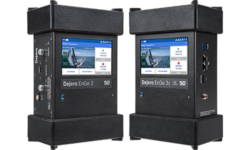5G: Should You Believe the Hype? Here’s What to Realistically Expect
5G shows plenty of promise. However, it is important to recognize where the technology currently stands and how it works.

This month we are going to take a moment and discuss some of the hype and facts on the emergence of 5G cellular networks. But before we get into this we are going to reflect back on the performance of wireless alarm technology.
When positioning transmitters throughout a facility one should be aware of characteristics like transmission power, receiver sensitivity, building structure and frequency of transmission. It is the latter that I want to comment on.
Have you noticed how certain devices with low frequency (long wavelength) will penetrate buildings better than higher frequency (short wavelength)? This characteristic will play an important role in further understanding 5G.
If there’s one thing that cellular 5G is not short on, it is promises. It will move data 100 times faster than the speed of present 4G. It will support 100 times as many devices as 4G systems. It will have much lower latency, around 10 milliseconds, than 4G.
One will be able to download a two-hour movie in 3.5 seconds versus six minutes on 4G. Sounds exciting, right? Well not so fast. Let’s dig further.
There are so many elements to 5G cellular service that many do not truly understand it. As we always preach in Tech Talk, it is important for security professionals to understand new technologies and to at least see where you might fit in the big scheme of things.
Much of the 5G hype in the public eye is not pointing to integrators … YET. However, keep an eye out as times are changing.
5G evolved from the 3GPP organization (3gpp.org) and is actually defined as 5G NR (5G New Radio). 5G can operate pretty much in any frequency between 600MHz and 40GHz. 5G cellular services come in two different flavors, or technically, a combination of two different frequency spectrums.
These categories are Sub-6 GHz 5G and Millimeter Wave 5G. Sub-6 GHz networks run on frequencies similar to 4G LTE. They use traditional cell towers and cover distances of 10+ miles. Sub-6 will have some small improved performance over 4G LTE.
The biggie that everybody is talking about is Millimeter Wave 5G. This will be deployed in the 28, 37 and 39GHz frequency bands. You will see very fast data transfer rates, low latency and high capacity.
Now, this is where our previous discussion on performance of high and low radio frequencies come in. The distance will be short (1,500-2,000 feet) and internal building penetration poor. Much money is now being spent by the major carriers to build up a supporting infrastructure for Millimeter Wave 5G.
It is estimated that carriers will need around 10,000 additional “small cells” (820 feet) just for New York City. Small cells are basically low power, small cellular antenna repeater arrays attached to buildings and utility poles.
While cellphone services are now getting the big hype on 5G, the truly amazing things are still to come, and they could take another five to 10 years. This is where integrators will have great opportunities. Enhanced mobile broadband, ultra reliable with low latency, will be provided to ultra-high definition, augmented/virtual reality, smart cities, buildings, homes, industry automation and self-driving cars.
It is just a matter of when this will start happening.
If millimeter waves are such a hassle one might ask is it worth the bother? Present cell service providers have a bandwidth of around 157MHz, supporting five frequencies. The 5G millimeter waves spectrum is expected to have 24 times today’s bandwidth. This will allow a considerable amount of data to be handled.
Recently I had the opportunity to listen in on a discussion by some top people in the communications industry. It was stated that as today’s hybrid 5G evolves into a standalone 5G, exciting things will start happening. It was further pointed out by officials that “cell tower density will go from 1,000 simultaneous signals to millions, latency will drop to under 1ms real-time (drones, remote surgery), Gig speeds. Also an explosion in sensors featuring low cost and low power. Everything will have a cheap, disposable, battery-powered 5G radio. Also visualized high speed networks.”
I would say that if one can look through the current 5G hype and are patient, 5G in the near future can be exciting for security dealers and integrators. As they say, there is a lot of potential here.
Another technology to keep an eye on is the Starlink satellite program from Elon Musk’s SpaceX company. This will provide high speed Internet service to rural customers, a counter to the 5G roll-out for densely populated metropolitan areas.

Tool of the Month
Strategic placement of 5G small cell repeaters will be critical. This month I have selected the 5G Modular Shroud from Comptek Techologies.
This is a very flexible, durable enclosure. A three-step installation ensures fast deployment.
If you enjoyed this article and want to receive more valuable industry content like this, click here to sign up for our FREE digital newsletters!

Security Is Our Business, Too
For professionals who recommend, buy and install all types of electronic security equipment, a free subscription to Commercial Integrator + Security Sales & Integration is like having a consultant on call. You’ll find an ideal balance of technology and business coverage, with installation tips and techniques for products and updates on how to add to your bottom line.
A FREE subscription to the top resource for security and integration industry will prove to be invaluable.














